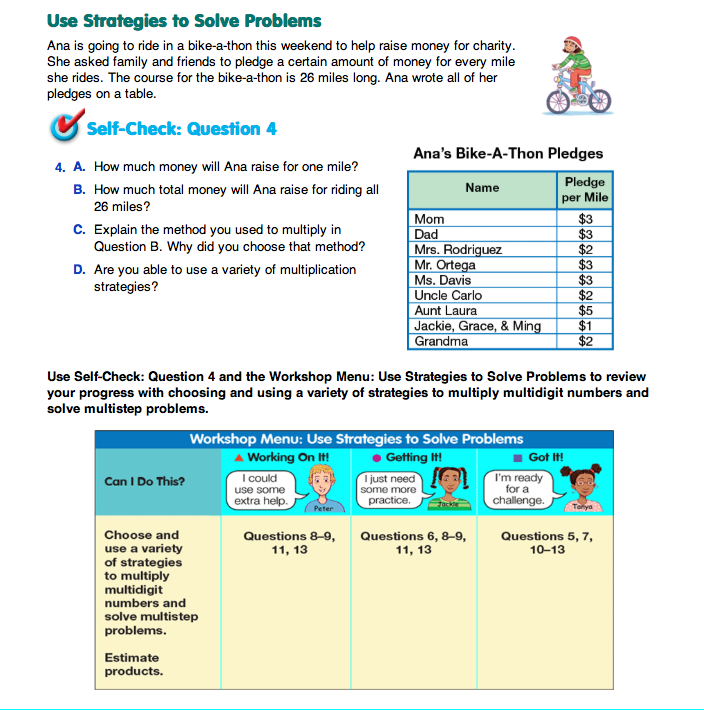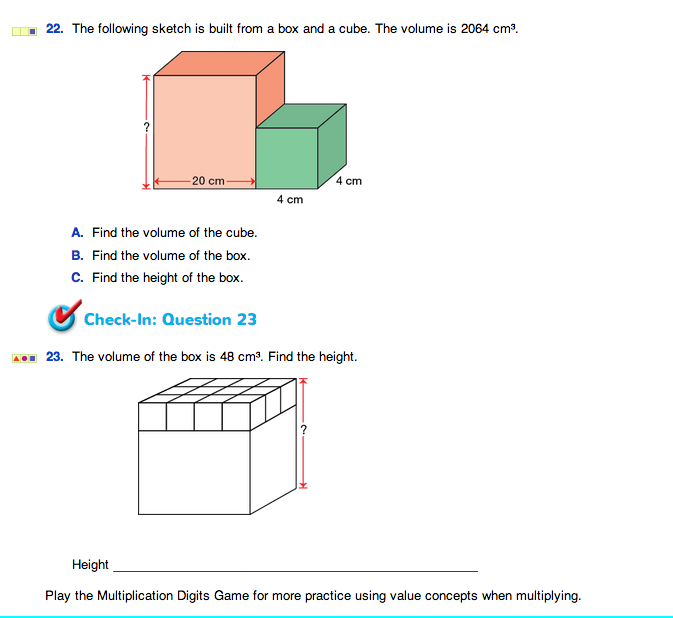Use Strategies to Solve Problems. Introduce the next part of the Workshop by asking students if they have ever participated in something like a walk-a-thon, bike-a-thon, or read-a-thon for charity.
- How does a bike-a-thon work? (Participants volunteer to ride a certain distance to raise money for charity.)
- How does a rider raise money for charity? (Riders ask people to pledge a certain amount of money to charity for every mile they ride. After riding,
they collect the money and turn it in to the charity organization.)
- How does a rider figure out how much money to collect for each pledge? (The rider multiplies the pledge per mile by the number of miles ridden.)
- What kind of things do you see at a bike-a-thon? (Possible responses: starting and finishing lines, bikes, riders, signs, spectators, water stations, snack stations)
- What kind of planning needs to take place to get ready for such an event? (Possible responses: setting the course, posting signs, setting up rest stations)
Direct students' attention to the Workshop: Multiplication Strategies pages in the Student Guide. Assign Self-Check: Question 4 in the Use Strategies to Solve Problems section. Students will choose a strategy to solve a multistep problem involving addition and multiplication. They are asked to explain why they chose the multiplication method they used, and whether they are able to use a variety of multiplication strategies. This question will help guide students in choosing appropriate practice in this section of the Workshop.
Students use Self-Check: Question 4 on the Workshop: Multiplication Strategies pages in the Student Guide to assess their abilities and choose practice multiplying multidigit numbers [E4]; choosing from among mental math, estimation, and paper-and-pencil methods to find products [E6]; and solving multistep problems [E7].
After students complete Self-Check: Question 4,
discuss the question with the whole class. Ask students to share the steps they took in their solutions and explain their reasoning. Facilitate a class discussion about what information was important in the problems, strategy choices, and how students labeled their answers. Then have students select practice from the Workshop Menu: Use Strategies to Solve Problems and begin to work.
Use Strategies to Find Volume. After a few groups of students have completed their selected problems in the Use Strategies to Solve Problems section, but before all students have completed their problems, introduce the next section to the whole class. Assign Self-Check: Question 14 in the Use Strategies to Find Volume section. In this question, students find the volume of a shape. Provide access to calculators. Have students try the Self-Check Question, discuss solutions, and choose problems from the Workshop Menu: Use Strategies to Find Volume with your guidance.

Some students may not have completed all of their selected questions in a section before you introduce the next section to the whole class. While this may mean interrupting students' flow of work, it is also important that students who complete problems more quickly are able to continue working. For students who need more time, unfinished problems can be completed at the end of the Workshop lesson as needed. They can also be sent home as homework. For students who finish all of their selected problems before the rest of the class, encourage them to work on more advanced problems from the menu or play the Multiplication Digits Game.
Students use Self-Check: Question 14 on the Workshop: Multiplication Strategies pages in the Student Guide to assess their abilities and choose practice with solving multistep problems using addition, subtraction, multiplication, and division [E7]; and using multiplication and division strategies to find the volume of boxes [E9].
Use Check-In: Question 23 on the Workshop: Multiplication Strategies pages in the Student Guide and the corresponding Feedback Box in the Teacher Guide to assess students' abilities to choose appropriately from among mental math, estimation, and paper-and-pencil methods to find products [E6]; solve multistep problems [E7]; use multiplication and division strategies to find the area of rectangles [E8]; use multiplication strategies to find the volume of boxes [E9]; know the problem [MPE1]; and find a strategy [MPE2].
















